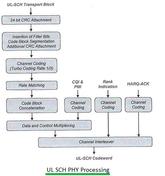LTE Channel Mapping: Logical, Transport, and Physical Channels
Advertisement
LTE (Long-Term Evolution) employs a hierarchical channel structure to ensure efficient data transmission between the user equipment (UE) and the network. Data traverses through logical channels, transport channels, and physical channels, guaranteeing the correct conveyance of information at different layers of the LTE protocol stack.
In this article, we will explore channel mapping in LTE, covering logical, transport, and physical channels, and understand the key functions of each channel type in LTE networks.

The diagram illustrates the mapping between the three channel types: logical, transport, and physical.
Logical Channels
Logical channels define the type of data being transmitted. They reside at the MAC (Medium Access Control) layer and are categorized based on the nature of the information they carry. Logical channels are divided into two types: control channels and traffic channels.
Control Channels:
- BCCH (Broadcast Control Channel): Broadcasts system information to all UEs.
- PCCH (Paging Control Channel): Used for paging UEs when the network wants to initiate communication.
- DCCH (Dedicated Control Channel): Carries control information between a specific UE and the network.
- CCCH (Common Control Channel): Used for control signaling when a UE does not yet have an RRC (Radio Resource Control) connection.
Traffic Channels:
- DTCH (Dedicated Traffic Channel): Carries user data between the network and a specific UE.
- MTCH (Multicast Traffic Channel): Used for multimedia broadcasting services.
Transport Channels
Transport channels represent how the data is transmitted over the air interface. They define the format of data transport blocks and are responsible for transferring data from the MAC layer to the physical layer. The transport channels also are divided into two types: Control and traffic channels.
Control Transport Channels:
- BCH (Broadcast Channel): Carries broadcast system information, such as cell-wide parameters.
- PCH (Paging Channel): Carries paging messages to alert UEs about incoming data.
- RACH (Random Access Channel): Used by UEs to initiate communication with the network.
Traffic Transport Channels:
- DL-SCH (Downlink Shared Channel): The main transport channel for user data and control information on the downlink.
- UL-SCH (Uplink Shared Channel): Used for carrying uplink data from a UE to the network.
- MCH (Multicast Channel): Supports Multimedia Broadcast Multicast Service (MBMS).
Physical Channels
Physical channels define where and when data is transmitted over the radio interface. They map the transport channels onto the actual resource elements (subcarriers and OFDM symbols) in the LTE air interface. Physical channels are categorized based on uplink and downlink directions.
Physical Downlink Channels:
- PDSCH (Physical Downlink Shared Channel): Carries user data and system information.
- PDCCH (Physical Downlink Control Channel): Carries control information for scheduling and resource allocation.
- PCFICH (Physical Control Format Indicator Channel): Informs UEs about the format of the downlink control channel.
- PHICH (Physical Hybrid ARQ Indicator Channel): Carries HARQ (Hybrid Automatic Repeat Request) feedback for uplink transmissions.
Physical Uplink Channels:
- PUSCH (Physical Uplink Shared Channel): Carries user data in the uplink.
- PUCCH (Physical Uplink Control Channel): Carries control information such as acknowledgment (ACK) or scheduling requests.
- PRACH (Physical Random Access Channel): Used by the UE for initial access to the network.
Process of Channel Mapping in LTE
In LTE, data flows through these layers:
- Logical Channels: Define the type of data.
- Transport Channels: Define how the data will be carried.
- Physical Channels: Define the actual transmission over the radio.
Example:
- A UE requests system access using the RACH (Transport Channel), which is mapped to the PRACH (Physical Channel).
- The network responds with a paging message sent over the PCCH (Logical Channel), mapped to the PCH (Transport Channel), and transmitted over the PDSCH (Physical Channel).
Conclusion
In LTE, data transmission is structured through logical, transport, and physical channels, each serving a distinct purpose. Logical channels define the data type, transport channels handle data transfer, and physical channels manage its transmission over the air interface. This structured channel mapping in LTE ensures efficient and reliable communication across networks.
Advertisement
 RF
RF





